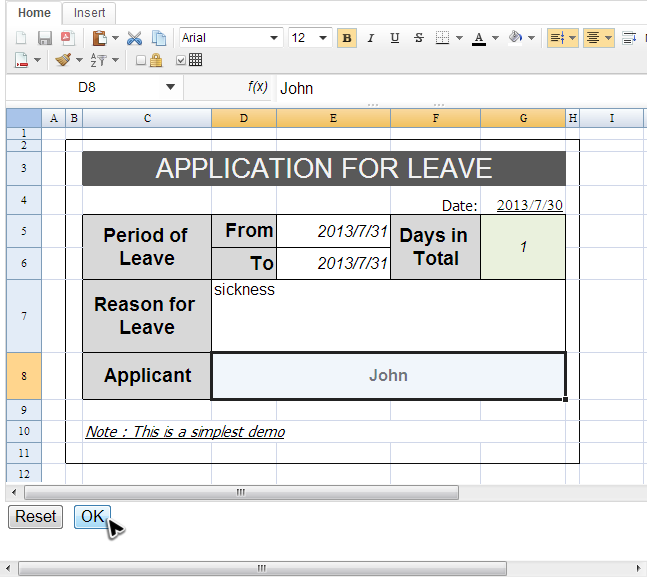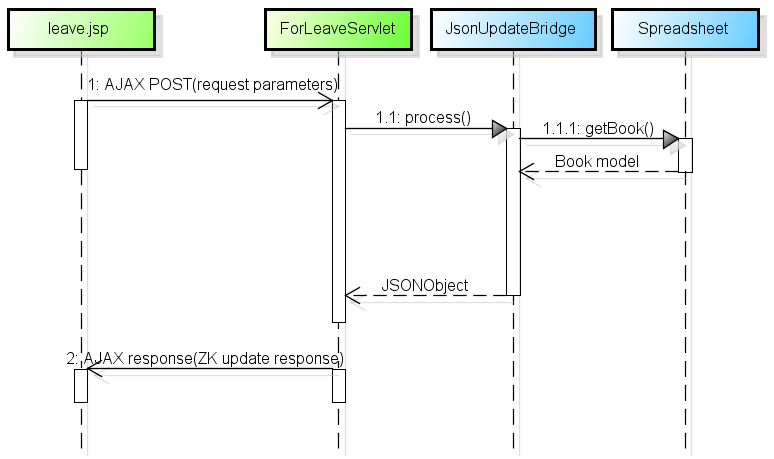Using Spreadsheet JSP Tag
Available in ZK Spreadsheet EE only
Overview
In this section, we will demonstrate how to make an HTML element, like a button, to interact with ZK Spreadsheet in a JSP using AJAX. As the ZK framework has integrated with jQuery, and we don't have to include jQuery's JavaScript library. This will be our first choice when using a JavaScript library. We assume you know some basics about jQuery.
The example application is a simple page to request for leave. A user fills the required field in cells and click "OK" button to submit his request for leave. Or he can clicks "Reset" button to reset what he inputs to default value. The screenshot below shows a request of a user "John":
We use Spreadsheet to make the application form and the two buttons are just ordinary HTML buttons.
Interaction between JSP and Spreadsheet
The sequence diagram displays the overall handling process of an AJAX request when a user clicks a button in app4l.jsp.
The app4l.jsp is the main page with the form for leave. The ForLeaveServlet is a servlet we implement for the example to handle AJAX requests from app4l.jsp. JsonUpdateBridge is a utility class that provides access to ZK desktop and starts an execution in a foreign AJAX channel. We should access components like spreadsheet in its process() method and it will generate a corresponding ZK AJAX response for us.
Firstly, app4l.jsp sends an AJAX request with required parameter such as desktop ID, spreadsheet UUID, and application related data to ForLeaveServlet. The servlet extracts necessary parameters to create JsonUpdateBridge object and call its process() to handle the AJAX request. Then responds with the JSON object which contains ZK AJAX response to the client. Then we use a Javascript utility object zssjsp provided by Spreadsheet to process ZK AJAX response and process other data of the JSON response according to our business logic.
Using Spreadsheet Tag
Using Spreadsheet JSP tag is like using any other JSP custom tag library. You have to declare a tag library with <%@taglib %> first and write Spreadsheet JSP tag with a specified prefix.
app4l.jsp
<%@page language="java" contentType="text/html; charset=UTF-8"
pageEncoding="UTF-8"%>
<%@taglib prefix="zssjsp" uri="http://www.zkoss.org/jsp/zss"%>
<!DOCTYPE html PUBLIC "-//W3C//DTD HTML 4.01 Transitional//EN"
"http://www.w3.org/TR/html4/loose.dtd">
<html>
<head>
<meta http-equiv="Content-Type" content="text/html; charset=UTF-8"/>
<title>Application for Leave</title>
<zssjsp:head/>
</head>
<body>
<div>
<zssjsp:spreadsheet id="myzss"
bookProvider="org.zkoss.zss.jspdemo.DemoBookProvider"
width="800px" height="500px"
maxrows="100" maxcolumns="20"
showToolbar="true" showFormulabar="true" showContextMenu="true"/>
</div>
<button id="resetBtn">Reset</button>
<button id="checkBtn">OK</button>
...
</body>
- Line 3, 10: Basic steps to use spreadsheet JSP tag.
- Line 14: A special attribute of spreadsheet JSP tag which should be specified as a book provider class name, and we will explain it later.
Book Provider
The line 15 in the previous code sample, app4l.jsp, has a special attribute which contains a book provider class name org.zkoss.zss.jspdemo.DemoBookProvider. The class implements an interface, BookProvider, which is used to load a book model programmatically in JSP or in a servlet. This provider is called when creating a Spreadsheet in ZK context. The returned book model will be set to a Spreadsheet.
public class DemoBookProvider implements BookProvider{
public Book loadBook(ServletContext servletContext, HttpServletRequest request, HttpServletResponse res) {
Book book;
try {
URL bookUrl = servletContext.getResource("/WEB-INF/books/application_for_leave.xlsx");
book = Importers.getImporter().imports(bookUrl, "app4leave");
} catch (Exception e) {
e.printStackTrace();
return null;
}
//initialize the book model
...
return book;
}
}
Send AJAX Request
The scenario is clicking a button to send an AJAX request, so we have to bind event listeners on buttons. To send an AJAX request with JQuery in JSP doesn't require any ZK knowledge, but the servlet needs desktop ID and spreadsheet's UUID to retrieve a ZK desktop and spreadsheet component. We can use a Javascript object zssjsp provided by Spreadsheet to get it.
Javascript in app4l.jsp
//jq is jquery name in zk, which version is 1.6.4 in spreadsheet
// 3.0.0 (zk 6.5.3 and later)
jq(document).ready(function(){
//register client event on button by jquery api
jq("#checkBtn").click(function(){
postAjax("check");
});
jq("#resetBtn").click(function(){
postAjax("reset");
});
});
function postAjax(action){
//get the necessary zk ids form zssjsp[component_id]
//'myzss' is the sparedhseet id that you gaved in
// sparedsheet tag
var desktopId = zssjsp['myzss'].desktopId;
var zssUuid = zssjsp['myzss'].uuid;
/*use jquery api to post ajax to your servlet (in this
demo, it is AjaxBookServlet), provide desktop id
and spreadsheet uuid to access zk component
data in your servlet */
jq.ajax({url:"app4l",//the servlet url
data:{desktopId:desktopId,zssUuid:zssUuid,action:action},
type:'POST',dataType:'json'}).done(handleAjaxResult);
}
- Line 5: The
jqis a variable that equals to$of jQuery integrated within ZK. - Line 17,18 : Use Javascript object
zssjspprovided by Spreadsheet to get desktop ID and spreadsheet's UUID with spreadsheet's component ID, "myzss". - Line 25: You can refer to JQuery API documenation about AJAX for details.
Handle AJAX Request and Response
The ForLeaveServlet is a servlet we implement to handle AJAX requests from app4l.jsp. It extracts necessary parameters from AJAX request to create JsonUpdateBridge object and call its process() to handle the AJAX request. Then responds with a JSON object which contains ZK AJAX response to the client.
We should override the JsonUpdateBridge's process() to implement our business logic and access spreadsheet component in it. Then JsonUpdateBridge will generate corresponding ZK AJAX response for us.
public class ForLeaveServlet extends HttpServlet{
@Override
protected void doPost(HttpServletRequest req, HttpServletResponse resp)
throws ServletException, IOException {
...
//parameter from ajax request, you have to pass it in AJAX request
//necessary parameter to get ZK server side desktop
final String desktopId = req.getParameter("desktopId");
//necessary parameter to get ZK server side spreadsheet
final String zssUuid = req.getParameter("zssUuid");
final String action = req.getParameter("action");
// prepare a json result object, it can contain your ajax result and
// also the necessary zk component update result
final JSONObject result = new JSONObject();
// set back for client to check action result, it depends on your logic.
result.put("action", action);
// use utility class to wrap zk in servlet request and
// get access and response result
JsonUpdateBridge bridge = new JsonUpdateBridge(getServletContext(), req, resp,
desktopId) {
@Override
protected void process(Desktop desktop) {
Spreadsheet ss = (Spreadsheet)desktop.getComponentByUuidIfAny(zssUuid);
Book book = ss.getBook();
Sheet sheet = book.getSheetAt(0);
if("reset".equals(action)){
handleReset(sheet,result);
}else if("check".equals(action)){
handleCheck(sheet,result);
}
}
};
/*
* Generate ZK update result in given JSON object. An AJAX response
* handler at client side, zssjsp, will 'eval' this result to update ZK
* components.
*/
bridge.process(result);
Writer w = resp.getWriter();
w.append(result.toJSONString());
}
...
}
- Line 10,12: Get desktop ID and spreadsheet UUID for they will be used in
JsonUpdateBridge - Line 27: Override
process()to implement business logic and access components. - Line 45: Invoke
JsonUpdateBridgeto handle AJAX request - Line 48: Convert result to JSON string and response to client.
Handling Spreadsheet Data Model
Inside JsonUpdateBridge.process(), you can use those APIs we mentioned in Handling Data Model to implement your business logic. In our example, we use Range to set cell edit text and get a value from the cells.
Reset Cells
The method handleReset() implements the business logic to clear user input back to default value.
public class ForLeaveServlet extends HttpServlet{
...
//reset cells to default value
private void handleReset(Sheet sheet, JSONObject result) {
final String dateFormat = "yyyy/MM/dd";
//you can use a cell reference to get a range
Range from = Ranges.range(sheet,"E5");//Ranges.range(sheet,"From");
//or you can use a name to get a range (the named range has to be set in Excel);
from.setCellEditText(DateUtil.tomorrow(0,dateFormat));
//set other cells...
}
Check Cells
The method handleReset() implements the business logic to validate user input and return a data for form element to submit at the browser.
public class ForLeaveServlet extends HttpServlet{
...
//validate cell data of user input and return a JSONObject
private void handleCheck(Sheet sheet, JSONObject result) {
Date from = Ranges.rangeByName(sheet,"From").getCellData().getDateValue();
Date to = Ranges.rangeByName(sheet,"To").getCellData().getDateValue();
String reason = Ranges.rangeByName(sheet,"Reason").getCellData().getStringValue();
Double total = Ranges.rangeByName(sheet,"Total").getCellData().getDoubleValue();
String applicant = Ranges.rangeByName(sheet,"Applicant").getCellData().getStringValue();
Date requestDate = Ranges.rangeByName(sheet,"RequestDate").getCellData().getDateValue();
if(from == null){
result.put("message", "FROM is empty");
}else if(to == null){
result.put("message", "TO is empty");
}else if(total==null || total.intValue()<0){
result.put("message", "TOTAL small than 1");
}else if(reason == null){
result.put("message", "REASON is empty");
}else if(applicant == null){
result.put("message", "APPLICANT is empty");
}else if(requestDate == null){
result.put("message", "REQUEST DATE is empty");
}else{
//Option 1:
//You can handle your business logic here and return a final result for user directly
//Or option 2: return necessary form data,
//so client can process it by submitting that can be handled by Spring MVC or Struts
result.put("valid", true);
JSONObject form = new JSONObject();
result.put("form", form);
form.put("from", from.getTime());//can't pass as data, use long for time
form.put("to", to.getTime());//can't pass as data, use long for time
form.put("reason", reason);
form.put("total", total.intValue());//we just need int
form.put("applicant", applicant);
form.put("requestDate", requestDate.getTime());
...
}
}
...
}
- Line 13: The
resultis a JSONObject that will be sent back to client. You can put any data you like according to your business requirement because you can get it inapp4l.jspand handle by yourself. In our case, we put a validation message in order and show it with Javascript. - Line 25: You can handle your business logic here and return a final result for users directly.
- Line 30: Here we return data for form element, and we submit a form at a browser in JavaScript.
Process AJAX Response
After the servlet sending the response, there is a segment of Javascript code which is responsible for handling response. This segment of code will perform some business logic according to the data in JSON object like showing validation message or submitting a form.
Javascript in app4l.jsp
function postAjax(action){
...
jq.ajax({url:"app4l",//the servlet url to handle ajax request
data:{desktopId:desktopId,zssUuid:zssUuid,action:action},
type:'POST',dataType:'json'}).done(handleAjaxResult);
}
//the method to handle ajax result from your servlet
function handleAjaxResult(result){
//process the json result that contains zk client update information
zssjsp.processJson(result);
//use your way to hanlde you ajax message or error
if(result.message){
alert(result.message);
};
//use your way handle your ajax action result
if(result.action == "check" && result.valid){
if(result.form){
//create a form dynamically to submit the form data
var field,form = jq("<form action='submitted.jsp'
method='post'/>").appendTo('body');
for(var nm in result.form){
field = jq("<input type='hidden'
name='"+nm+"' />").appendTo(form);
field.val(result.form[nm]);
}
form.submit();
}
};
}
- Line 5: Specify AJAX response handling method with
handleAjaxResultwhen we send AJAX request. - Line 11: Use
zssjspto process ZK AJAX response in responsed JSON object, e.g. reset data in cells. - Line 14: Display a validation message if it exists.
- Line 29: Submit a form whose data comes from JSON object. This technique can be used to trigger another controller of Spring MVC's or Struts.
Source Code of Example
Source code of above example application can be accessed in github.
All source code listed in this book is at Github.

